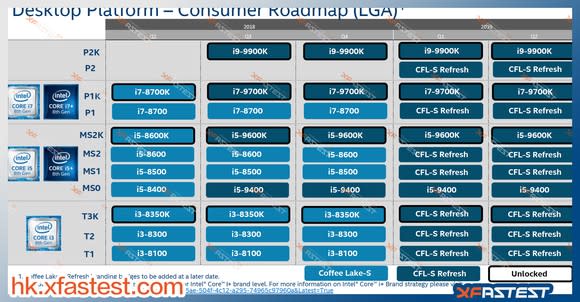Intel's Smart Plan to Boost Desktop Processor Prices
In the second quarter of 2018, chip giant Intel (NASDAQ: INTC) reported that its client computing group business, which makes most of its money by selling processors and products complementary to personal computers, enjoyed a nearly 6.3% increase in revenue.
Interestingly, Intel reported that its desktop platform shipments dropped 9% year over year (Intel says that platforms "incorporate various components and technologies, including a microprocessor and a chipset, a stand-alone [system-on-a-chip], or a multi-chip package"), but its desktop platform average selling prices rose 13% for a net increase of 6.4% in desktop platform sales in the quarter.

Image source: Intel.
"Our revenue in Q2 2018 and in [year-to-date] 2018 increased from strong demand in commercial and gaming market segments, and higher demand for our high-performance processors which more than offset the volume decline," Intel explained in its form 10-Q filing with the Securities and Exchange Commission.
With its upcoming desktop processor lineup, which is expected to be sold as the company's ninth-generation Core processors, Intel is making a move that could help drive its desktop platform average selling price, and by extension its revenue from desktop platforms, up further. Let's take a closer look.
Introducing the Core i9 for mainstream desktops
Traditionally, Intel has offered the following three tiers of its Core processors for both laptop and desktop processors: Core i3, Core i5, and Core i7.
Back in 2017, with the launch of its current high-end desktop processors, the company introduced the Core i9 branding tier. Intel later brought that Core i9 branding to its highest-end notebook processor, the Core i9-8950HK, which is used in premium gaming-oriented laptops as well as the top configuration of Apple's (NASDAQ: AAPL) latest 15-inch MacBook Pro.
The company's mainstream desktop processors (the chips that make up the vast majority of Intel's desktop processor sales), however, currently only top out at Core i7 -- something that's set to change when the company launches its ninth-generation Core processors later this year (the latest rumors point to an October launch).
Take a look at the following slide published by XFastest (via PC-component news site VideoCardz):

Image source: XFastest via VideoCardz.
Notice in this slide, Intel's current Core i7-8700K, its highest-end mainstream desktop processor, is in the "P1K" product tier -- the highest tier as of the second quarter of 2018. However, if you move one column over, you see that the Core i7-8700K is replaced by a part known as the Core i7-9700K in that same "P1K" tier.
What's new here is that Intel is introducing a new product tier above P1K/P1 -- P2K/P2. The highest-end model listed is the Core i9-9900K, which will be the first mainstream Intel desktop processor to carry the Core i9 moniker. It's also a virtual certainty that the processors in the P2K/P2 tiers will be more expensive than their P1K/P1 counterparts.
Potential impact on Intel's business
The good news for Intel is that the major players in the personal computer ecosystem have an incentive to move systems with the higher-end Core i9 chips inside. For example, Apple charges customers an extra $300 for a 15-inch MacBook Pro with a Core i9 processor compared to an equivalent model with a Core i7. Anything that can help system vendors like Apple collect that premium seems positive for Intel.
Moreover, personal computers are often sold at retail. Not only do the companies that produce computers want to sell customers on higher-end computers, but resellers of those computers likely want to sell the highest-priced products that they can as well, as it means more revenue for them.
Ultimately, Intel's goal in introducing the Core i9 branding in portions of its product lines is to make it easier for computer makers and distributors to sell higher-priced machines, with higher-priced Intel processors, to end users. Once Intel's ninth-generation Core processors launch for the desktop, be sure to keep a close eye on the desktop platform average selling price trends the company reports in the quarters that follow.
More From The Motley Fool
Ashraf Eassa has no position in any of the stocks mentioned. The Motley Fool owns shares of and recommends Apple. The Motley Fool has the following options: long January 2020 $150 calls on Apple and short January 2020 $155 calls on Apple. The Motley Fool has a disclosure policy.
